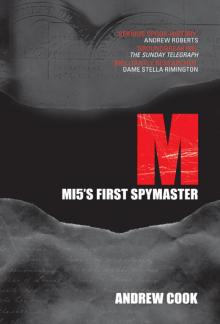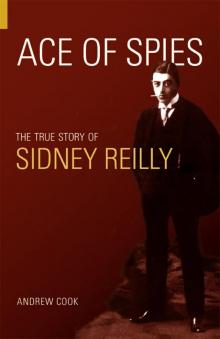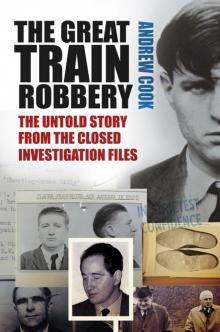- Home
- Andrew Cook
The Great Train Robbery
The Great Train Robbery Read online
To Alia
ACKNOWLEDGEMENTS
I would like to thank all those involved in the research and development of this book, and the following people for their invaluable help:
Jordan Auslander, Bill Adams, David Baldry, Phil Tomaselli, Gavin McGuffie (BPMA), Jamie Ellal (BPMA), Sally Jennings (BPMA), Vicky Parkinson (BPMA), Helen Potter (TNA), Amelia Bayes (TNA), Lizzie Mould (Croydon Local Studies & Archives Service), Bob Askew (Southwark Council, Local History), Martin Robson Riley (National Museum of Wales), Andrew Foster (Railway History Group), Jen Parfitt (Solicitors Regulation Authority), David Capus (Records Management Branch, Metropolitan Police), Philip Barnes-Warden (The Met Historical Collection), Neil Paterson (The Met Historical Collection), Samantha Cardoo (Royal Mail Group Security), Tony Marsh (Group Security Director, Royal Mail Group), Janet Altham (DPP/CPS), John O’Connor (former Head, Flying Squad), Bob Fenton (EMCA), Philip Trendall (BTP), Edward Laxton (formerly of the Daily Express), Ray Brown (formerly of Lessor & Co.), Frank Campion (formerly of Lessor & Co.), Harry Lyons (former Assistant Controller, Post Officer IB), Bob Robertson (former Flying Squad), Edward Harris (former Flying Squad), Marlena Wilson (granddaughter of Percy Hoskins), Hazel Collinson (wife of Peter Collinson), Colin Williams (son of Frank Williams), Marian Ikin (daughter of Clifford Osmond), Roger Lemon, James Carpenter and Colin McKenzie.
Furthermore, I would like to thank Bill Locke at Lion Television (Executive Producer of the Channel 4 film The Great Train Robbery’s Missing Mastermind?), whose support and encouragement enabled me to take this project forward. I am also indebted to all those who were involved in the production of the film, in particular Matthew Whiteman, Luke Martin and Daisy Robertson.
Finally, my thanks to Chris Williamson, Beryl Rook, Alia Cook, Alison Clark, Nabeel Bashir, Simon Hamlet (who commissioned this book) and Lindsey Smith at The History Press.
CONTENTS
Title
Dedication
Acknowledgements
Preface
Introduction
1. The 2.25 to Brighton
2. The Hold-Up
3. The 30-Minute Clue
4. Robbers’ Roost
5. The Poppy
6. An Inside Job
7. Through the Looking Glass
8. Blind Man’s Bluff
9. And Then There Were Six
10. Operation Primrose
11. Fish on a Hook
12. Case for the Defence
13. An Act of Warfare
14. The End of the Beginning
Appendix 1 Jack Mills
Appendix 2 The Vehicles
Appendix 3 The Court
Appendix 4 Forensic Evidence on Gordon Goody’s Shoes
Appendix 5 Metropolitan Police Structure 1963
Appendix 6 Roy James’s Motor Racing Record
Abbreviations
Bibliography
Plates
Copyright
PREFACE
Just after 3 a.m. on Thursday 8 August 1963, a crime took place that still stands as the heist of the century. A gang of professional thieves made history when they held up the Glasgow to London Travelling Post Office train and seized a record-breaking haul of £2.6 million (just over £50 million in today’s money).
Much has been written about it over the past five decades in books, magazines and newspapers. A host of films and television documentaries have also ensured that not one year has passed since 1963 without coverage of the story and the characters involved.
However, despite the wealth and extent of coverage, a host of questions have remained unanswered about the Great Train Robbery: who was behind it, was it an inside job and who got away with the crime of the century? Fifty years of selective falsehood and fantasy, both deliberate and unintentional, has obscured the reality of the story behind the robbery. The fact that a good many files on the investigation and prosecution of those involved, and alleged to have been involved, are closed in many cases until 2045 has only served to muddy the waters still further. To piece together an accurate picture of the crime and those surrounding it, it is necessary to return to square one, starting from scratch in gathering together as many primary sources as possible. The ability to draw upon many formally closed, restricted or hitherto unpublished primary sources have helped in this task immeasurably.
Contemporary, primary source material undoubtedly gives the reader a totally new ‘feel’ for the case and the social attitudes of the period. The sheer volume of material also brings home just how easy it can be, without the ability to cross-reference other sources and investigations, to overlook certain details and key links. Many theories about the crime were expounded at the time, particularly in the popular press. Some of them were far-fetched; others were rooted in more reliable, off-the-record sources.
Files on the robbery held by the Metropolitan Police, the Home Office, Buckinghamshire Assizes, the British Railways Board and the Director of Public Prosecutions are vast and impossible to quote in full, as are the files held by Royal Mail, the British Transport Police and the contemporary newspaper reports held by the British Library. Therefore, a degree of selectivity has been applied, but not in such a manner as to compromise the integrity of the source material available. All the main official accounts and reports pertinent to the parallel investigations carried out by the various agencies are included in this book.
The objective of this book is to present as full and factual an account of the Great Train Robbery as is possible, chronologically presented and told by the people who played a role in the story. It is left to the reader to interpret the facts and evidence accordingly. Due to the great extent of abbreviations and initials used in the various documents, the reader is advised to periodically refer to the ‘Abbreviations used in Source Notes’ at the end of this book.
INTRODUCTION
The term ‘The Great Train Robbery’ was neither born as a result of the 1963 mail train hold-up, nor indeed the 1855 train robbery immortalised by Michael Crichton in his 1975 novel The Great Train Robbery (which was later filmed by MGM in 1978 as The First Great Train Robbery starring Sean Connery and Donald Sutherland).
While Crichton’s book was a work of fiction, it drew heavily upon real-life events that took place on the night of 15 May 1855 when the London Bridge to Paris mail train was robbed of 200lb of gold bars. Crichton took something of a historical liberty by retrospectively re-christening it the Great Train Robbery. At the time, and for over a century afterwards, it was commonly known as the ‘Great Gold Robbery’.
The term ‘The Great Train Robbery’ has, in fact, no basis at all in any real-life event; it is instead the title of a 1903 American western movie written, produced and directed by Edwin S. Porter. Lasting only twelve minutes, it is still regarded by film historians as a milestone in movie-making. Shot not in Hollywood but in Milltown, New Jersey, its groundbreaking features include cross-cutting, double exposure composite editing and camera movement.
When, within twenty-four hours of the 1963 mail train robbery, the enormity of the heist began to sink in and the British press frantically searched for a suitable iconic headline, Edwin Porter’s 60-year-old movie title fitted the bill perfectly. Ironically, Fleet Street went one stage further the following week when, on the discovery of Leatherslade Farm, they dubbed it ‘Robbers’ Roost’. This secluded location in southern Utah was, in fact, a favourite hideout of the American outlaw and train robber Butch Cassidy and his ‘Hole in the Wall Gang’ back in the 1890s.
Mail was first carried in Britain by train in November 1830, following an agreement between the General Post Office and the Liverpool & Manchester Railway. Eight years later, Parliament passed the Railways (Conveyance of Mails) Act, which r
equired railway companies to carry mail as and when demanded by the postmaster general. Trains carrying mail eventually became known as TPOs (Travelling Post Offices). Mail was sorted on a moving train for the first time in January 1838 in a converted horsebox on the Grand Junction Railway. The first special postal train was operated by the Great Western Railway on the Paddington to Bristol route, making its inaugural journey on 1 February 1855.
Because of the wide expanse of territory in the American West and Mid-West, train robbers tended to stop trains by placing obstructions on the track to halt the locomotive, or by boarding the train, jumping into the back of the locomotive and holding up the engineer and fireman.
The location chosen was usually a desolate or isolated stretch of line, miles away from the nearest town, where plenty of time would be available to rob the train and make a getaway well before the alarm was raised. Unlike the 1855 ‘Great Gold Robbery’ in England, there was no need to rob the train while it was in motion. Train robberies carried out by the likes of Jesse James and Butch Cassidy would have been impractical, if not near impossible, in Victorian England due to the short distance between stations and the observant signal box system.
By the time Butch Cassidy and his Wild Bunch hit the Union Pacific train at Tipton on 29 August 1900, the writing was already on the wall for American train robbers. The Board of the Union Pacific Railroad Company had resolved to spend money to save money - by employing the Pinkerton Detective Agency. Their agents, such as the legendary Joe Lefors, were usually well paid, well armed and mandated to take the fight directly to the train robbers. This they did by tracking them, sometimes for months on end, until they were arrested or forced into a gunfight. Unlike US law officers, Pinkertons were not constrained by state boundaries, which escaping robbers had previously exploited by criss-crossing. Pinkertons’ strategy, although criticised in many quarters as a shoot-to-kill policy, was to prove particularly effective in combating railroad robberies.
Unlike America, the regional railway companies in Britain (GWR, LMS, LNER and SR) were permitted by Parliament to employ their own railway police constabularies. With the nationalisation of the railways in 1948 and the creation of one sole state-owned company, British Railways, these private-company police forces became one constabulary known as the British Transport Commission Police. In Britain there was no need to employ the likes of Pinkertons to investigate mail crime, as a highly effective official force had operated in the shadows for over 300 years.
The Post Office Investigation Branch (IB) has a just claim to be the world’s oldest criminal investigation department, tracing its origins back to 1683, when King Charles II appointed Attorney Richard Swift to the General Post Office (GPO) with specific responsibility for ‘the detection and carrying on of all prosecutions against persons for robbing the mails and other fraudulent practices’. On a salary of £200 per year Swift was, according to GPO records, an effective bulwark against post office crime. A Treasury department letter of 1713 affirms that, ‘Richard Swift has been Solicitor to the General Post Office for about thirty years in which he has all along acted with great diligence, faithfulness and success.’1
During the eighteenth and early nineteenth centuries, reports of the apprehension and sentencing of post office offenders appeared regularly in local and national newspapers. The Evening Mail of 8 May 1795, for example, reported in some detail on the case of a letter sorter by the name of Evan Morgan, who had been arrested and charged with ‘secreting a letter at the Post Office’. He was hung on 20 May at Newgate Prison. Of particular note was the fact that three of the six men hung that day were postmen.
The sentences for post office crimes were historically harsh, as demonstrated by the records from that era, which show that both capital punishment and transportation to the colonies were common. In 1765, Parliament passed an act that set down the death penalty for ‘theft of the mail’, ‘secretion’ and ‘embezzlement or destruction of mail’. A further twenty-nine postmen were hung between that date and the passing of the 1837 Post Office Act, which abolished the death penalty for post office offences, replacing it with transportation for terms of seven years to life.
In terms of investigating such offences, responsibility remained with the solicitor to the Post Office until 1816, when much of it was transferred to the Secretary’s Office, where the team of investigators were to become known as the Missing Letter Branch. By 1823 the investigators were supplemented and supported by Bow Street Runners. Founded by Henry Fielding in 1750, the Runners (or Robin Redbreasts, on account of their scarlet waistcoats) were London’s first band of constables who travelled up and down the country serving writs and pursuing criminals. In 1829, on the founding of the Metropolitan Police by Sir Robert Peel, the Missing Letter Branch used seconded police officers instead.2
In 1840 the introduction of the first postage stamp, the penny black, led to a massive increase in the volume of postal traffic. This inevitably meant a consequent rise in the amount of post office-related crime. The Post Office reacted to this by recruiting more investigators who, from 1848, were placed under the supervision of the Post Office inspector general in a separate department. In 1883, the Missing Letter Branch was renamed the Confidential Enquiry Branch and the officer in charge given the title of director. In 1908 the unit once again changed its name to the Investigation Branch, usually shortened to the IB. In 1934 the GPO underwent a radical reorganisation, and in 1935 the Investigation Branch became one of the administrative departments of the new headquarters structure of the GPO. In 1946 the title of the head of the Investigation Branch changed from director to controller. At the time of the 1963 train robbery, Clifford Osmond was controller, having taken over the post in 1957. Formally deputy controller from 1948, Osmond, a native of the West Country, had joined the Post Office at the age of 18 before successfully applying to join the Investigation Branch in March 1934.3
In retrospect, the Post Office was most fortunate in having Osmond, a highly motivated, resourceful and effective investigator, at the head of the organisation during a period in which mail crime was to rise significantly and, indeed, culminate in the Great Train Robbery of 1963.
Notes
1. Sources for the early history of the IB and its predecessors: POST 23/13-66; Missing Letter Branch case papers, 1839−1859; POST 30/1492 Confidential Enquiry Branch (GPO): Revision, 1907; Historical summaries of Branch workings and grades employed, 1793−1907; POST 74 Solicitor’s Department; POST 74/199−203 Prosecutions in England and Scotland, 1800−1896; POST 74/204−344; Prosecution Briefs in England, Ireland and Wales, 1774−1934; POST 122/13084 Investigation Branch Annual Reports 1957/58−1966/67.
2. Ibid.
3. Ibid.
1
THE 2.25 TO BRIGHTON
In the 1950s and early ‘60s Percy Hoskins was considered by his peers, and indeed many senior police officers up and down the country, to be Britain’s foremost crime reporter. As chief crime reporter for Lord Beaverbrook’s mass circulation Daily Express, he had an almost sixth sense when it came to spotting a unique story angle and a second-to-none ability to get down to its bedrock.
Hoskins was famed for the friendships and acquaintances he cultivated over the years, not only in Britain but also in America, such as Hollywood film director Alfred Hitchcock and FBI Director J. Edgar Hoover. He also had some of the best sources in the criminal fraternity, the Metropolitan Police and the outlying county forces. According to Victor Davis, writing in the British Journalism Review, ‘Hoskins kept open house for senior police officers at his flat at 55 Park Lane; if you were in trouble with the police you rang Percy before your lawyer.’
According to Davis, Hoskins avoided having a desk at the Daily Express HQ at 120 Fleet Street, in the City of London (known unofficially at the time as the ‘Black Lubyianka’), so as to avoid Beaverbrook executives keeping a tab on his working hours. During his fifty years working for Beaverbrook newspapers, Hoskins became a personal friend of Lord Beaverbrook and earned a
mixture of notoriety and admiration in Fleet Street for the stance he took in his stories. The most noteworthy example being the landmark case of suspected serial killer Dr John Bodkin Adams in 1956, on which Hoskins was the lone voice in Fleet Street not assuming Adams’s guilt.
Initially seen by Beaverbrook as an almost suicidal position for the newspaper to be taking, he phoned Hoskins after Adams was found not guilty by an Old Bailey jury and told him, ‘Two people were acquitted today’ – meaning that Hoskins would keep his job and his reputation. The Daily Express was also highly fortunate to have a second-to-none team of crack crime reporters who worked with Hoskins during the 1950s and ‘60s, comprised of Edward Laxton, Arnold Latchman, Rodney Hallworth and Frank Howitt.
The Daily Express team first got wind of an escalating number of mail thefts on the London to Brighton main line in the late summer of 1960. The first incident occurred in August and resulted in the loss of £7,500 from nine mailbags. The Daily Express reported the following day that three hooded men tied up the guard of the 2.25 p.m. London to Brighton express and escaped with the cash that had been taken from High Value Packets (HVPs) in the mailbags.
Hoskins was a regular passenger on the line, having a weekend home near Brighton, and had good contacts with a number of Sussex police officers. He soon picked up on the second incident the following month, ‘when a train was halted outside Patcham Tunnel, Preston Park, by a rigged signal’. The Daily Express report went on to tell readers that, ‘masked bandits over-powered the guard and snatched £9,000 from mailbags’.
By now the Post Office Investigation Branch had become involved and was particularly concerned that the robbers appeared to have a degree of technical know-how in being able to halt trains by manipulating the signals. This is clear from a memo sent by IB controller Clifford Osmond to his Royal Mail security counterparts, Postal Services Department (HMB), on 21 September 1960:

 M
M Ace of Spies
Ace of Spies The Great Train Robbery
The Great Train Robbery The Ian Fleming Miscellany
The Ian Fleming Miscellany